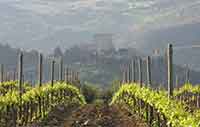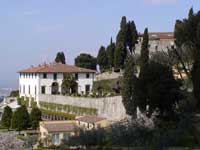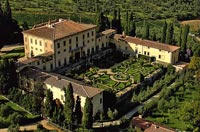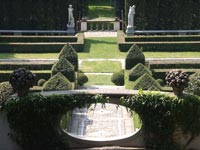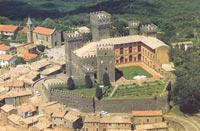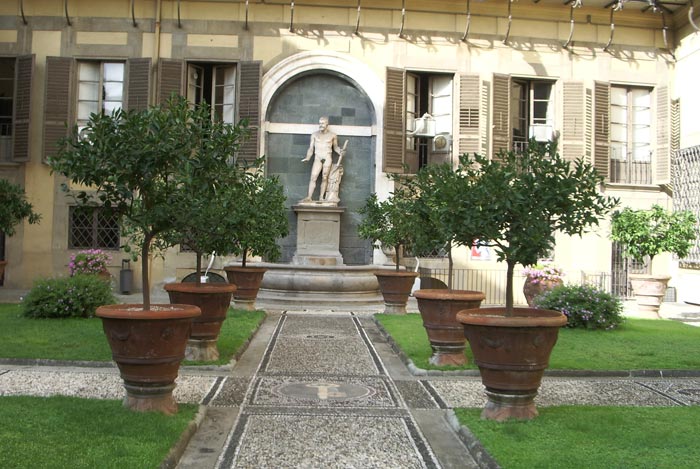 |
Garden of Palazzo Medici-Riccardi in Florence, the second courtyard decorated with ornamental statues and potted lemon trees
|
Garden of Palazzo Medici-Riccardi in Firenze |
| Towards 1445 Cosimo de’ Medici, known as Cosimo il Vecchio, launched the construction of his own residence on Via Larga, on the corner with Via de’ Gori.open a box elaborating the argument dealt with in a new window He entrusted the commission for the work to the architect Michelozzo di Bartolomeo. According to the sources, Cosimo had previously rejected a design presented by Filippo Brunelleschi “because it was too lavish and magnificent” and would “arouse envy among the citizens, rather than being a grand ornament for the city, and comfortable in itself” (G. Vasari, 1568). Completed about ten years later, the Palazzo Medici designed by Michelozzo appeared as a completely new style of building within the Florentine urban panorama, capable of combining tradition (pietra forte, or fine grained sandstone, and rustication) with the new Renaissance concepts. In comparison to the present building, extended in the seventeenth century, the palazzo of Cosimo il Vecchio had the appearance of a cube, at once austere and elegant, presenting a corner view to those arriving from the Duomo. The facade on Via Larga was made up of ten bays, with another nine on the Via de’ Gori side. |
The Palazzo Medici, also called the Palazzo Medici-Riccardi for a later family that acquired and expanded it, is a Renaissance palace located in Florence. The palace was designed by Michelozzo di Bartolomeo for Cosimo de' Medici, of the great Medici family, and was built between 1444 and 1460. It was well known for its stone masonry that includes rustication and ashlar. ...a house that is— as much in the handsomeness of the ceilings, the height of the walls, smooth finish of the entrances and windows, number of chambers and salons, elegances of the studies, worth of the books, neatness and gracefulness of the gardens, as it is in the tapestry decorations,[5] cassoni of inestimable workmanship and value, noble sculptures, designs of infinite kinds, as well of priceless silver— the best I may ever have seen..."[6] Niccolò de' Carissimi, one of Galeazzo Maria's counsellors, furnished further details of the rooms and garden: "decorated on every side with gold and fine marbles, with carvings and sculptures in relief, with pictures and inlays done in perspective by the most accomplished and perfect of masters even in the very benches and floors of the house; tapestries and household ornaments of gold and silk;silverware and bookcases that are endless... then a garden done in the finest of polished marbles, with diverse plants, which seems a thing not natural but painted."[7] Cosimo received the young Sforza in the chapel "not less ornate and handsome than the rest of the house." The palazzo still includes, as its only quattrocento interior that is largely intact, the notable Magi Chapel, frescoed by Benozzo Gozzoli, who completed it in 1461 with a wealth of anecdotal detail of character types so convincing they were traditionally held to be portraits of members of the Medici family, along with the emperors John VIII Palaiologos and the Emperor Sigismund of Luxemburg, parading through Tuscany in the guise of the Three Wise Men.[8]The Medici were thrown out of Florence because the Florentines prided themselves on their republic and saw the Medici family as a threat to that power. When the Medici family returned to Florence, they kept a low profile and executed their power behind the scenes. This "low profile" is reflected in the plain exterior of this building, and is said to be the reason why Cosimo de' Medici rejected Brunelleschi's earlier proposal. The palace was the site of the wedding reception between Ferdinando de' Medici, Grand Prince of Tuscany and Violante Beatrice of Bavaria in 1689. Notes Palazzo Medici Riccardi official website
|
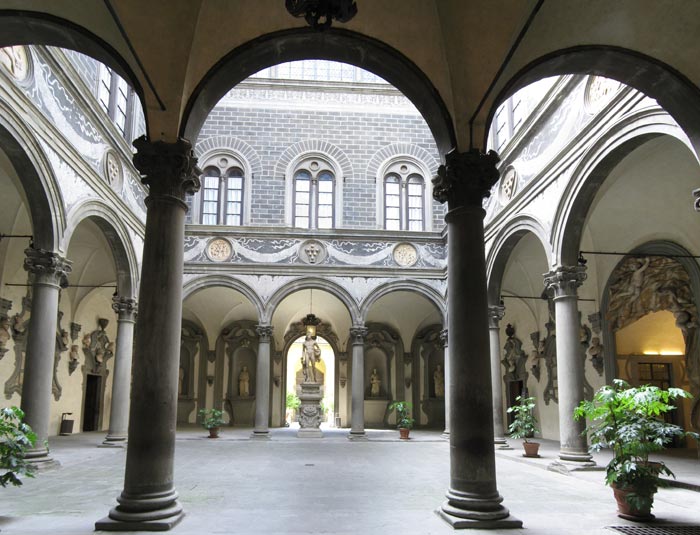 |
Garden of Palazzo Medici-Riccardi in Florence, courtyard |
| From the early years of the fifteenth century the Medici sponsored the construction of important buildings in the vicinity of Via Larga, which in the eyes of the citizens appeared as exemplary and clearly visible landmarks of the Medici quarter. Giovanni di Bicci immediately took a prominent part in the initiatives proposed by the Canons of San Lorenzo for the construction of the new church, showing himself to be the most enthusiastic and generous of the patrons in the funding of the enterprise. As a result of his initiative, before his death in 1429 he had seen the completion of the work on the sacristy (later known as the Sagrestia Vecchia) executed by Filippo Brunelleschi, who was also responsible for the design of the church. Giovanni assigned the sacristy – which was not by chance dedicated to St John the Evangelist – to the role of funereal chapel to house his own remains and those of his wife, Piccarda. Since then, for centuries, the descendants of Giovanni de’ Bicci considered San Lorenzo as the family church, destined to commemorate the memory of the dynasty and its most illustrious members. n 1436, at the order of Cosimo il Vecchio who had returned to Florence from exile, Michelozzo began the rebuilding of the church and convent of San Marco, which had been taken over by the Dominicans of the Osservanza di Fiesole, an order which was very close to the Medici. In the monastery, splendidly frescoed by Fra’ Giovanni da Fiesole known as Beato Angelico, Cosimo founded an important library, with access also from the outside, and had a cell for his personal use. He also transferred to the convent premises the headquarters of three confraternities, the Fanciulli, the Tessitori and the Magi, with an entrance on Via Larga. The Confraternity of the Magi, to which the members of the family belonged, was responsible for one of the most important city festivals, celebrated on the day of the Epiphany, and centred on a spectacular procession along Via Larga. In 1442, as the work on San Marco was nearing completion, Cosimo largely took over the patronage of the construction of the complex of San Lorenzo, termination of which was faltering. When Cosimo died in 1464 his remains were positioned in a place of honour, symbolising his role as founder of the family fortunes, as well as the major patron of the church. The sarcophagus is in fact set into one of the load-bearing pillars in the centre of the crypt of San Lorenzo, marked in the nave of the church by an inlaid marble tombstone with inscription set before the high altar. Meanwhile, throughout the fifteenth century up to the early decades of the sixteenth, the Medici continued to purchase houses and gardens on Via Larga, especially on the western side. As well as this many of the friends and supporters of the Medici lived on the same street, including the architect Michelozzo, and Agnolo Poliziano, poet and tutor to the sons of Lorenzo il Magnifico. In 1455 Cosimo il Vecchio bought a property close to the convent of San Marco. During the following decades, this area of Medici property was increasingly extended, and Lorenzo il Magnifico then set up here the “sculpture garden” or garden of San Marco, where artists could study archaeological pieces and modern works. In this sort of training-ground for young talents, the illustrious patron came to know the young Michelangelo, whom he then took under his protection. At the end of the fifteenth century, during the processions and parades which were held on public feast-days and during the visits of illustrious personages, Via Larga was seen pre-eminently as the street of the Medici, the major landmarks of which (the church of San Marco, the sculpture garden, Palazzo Medici, the nearby San Lorenzo) were buildings under the patronage of the illustrious family, solidly establishing its fame and its primacy over time. Gardens in Tuscany | Medici Riccardi Palace | www.palazzo-medici.it |
 Giovanni di Cosimo de' Medici. Detail from the fresco by Benozzo Gozzoli, in the Cappella dei Magi, at Palazzo Medici Riccardi in Florence, Italy. |
|||
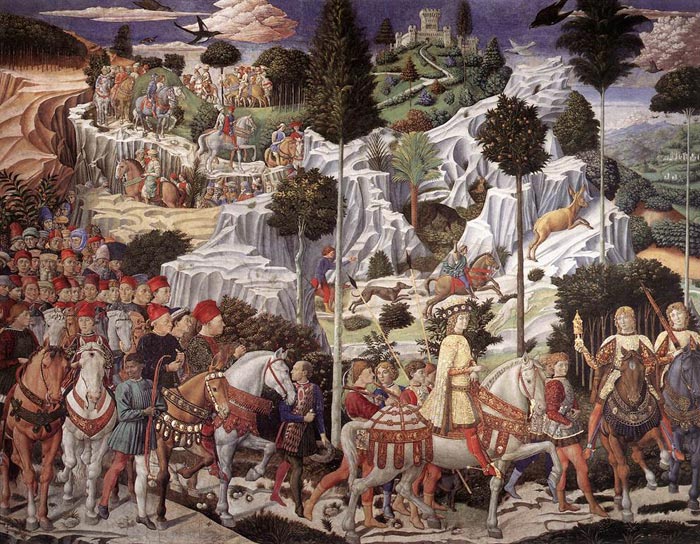 |
||||
Benozzo Gozzoli, Procession of the Youngest King (detail), 1459-60, Palazzo Medici-Riccardi, Firenze |
||||
| The magnificent and solemn Procession of the Magi portrayed by Gozzoli in the chapel of Palazzo Medici, sets off from Jerusalem – the white fortified city which can be seen aloft on the right-hand side on entering – and stretches out towards Bethlehem, taht is towards the scarsella. The Magi, each occupying one wall of the main room, are portrayed in the traditional manner: Gaspar is the youngest, dressed in white, Balthasar, in green, is a dark-skinned man of mature years, while the eldest Melchior, in red, leads the procession. The choice of the subject can be explained by the interest which the Medici revealed in the story of the Magi. Effectively the family were patrons of the Confraternita dei Magi which had its headquarters in the nearby convent of San Marco and every year organised a lavish re-enactment of the gospel story on the day of the Epiphany, with a long procession in costume passing along Via Larga in front of the family mansion. Gozzoli’s fresco may even be considered a reflection of this spectacular celebration. The procession illustrated in the Chapel of the Magi features many extremely vivid portraits, although they are not always easy to identify. These transport the religious subject to the contemporary setting of fifteenth-century Medici Florence. he young Gaspar, who symbolises the ascent of the Medici family, leads a group in which, among others, members of the Medici family itself are portrayed: in the foreground, the elderly Cosimo on a mule, and his son Piero on horseback with a red hat; in the second row, we can see Piero’s sons including Lorenzo (the future Lorenzo il Magnifico) at the age of ten. Behind these we find the self-portrait of Benozzo Gozzoli, with his name written in gold lettering on his beret. In the fresco, the solid perspective layout of the composition is blended with a richness of detail and the taste of a narration at once worldly and fabulous. The faces of the personages - portraits of the Medici, and also of their allies, collaborators and illustrious guests – the florid and varied landscape, the plants and flowers, the animals, some of them exotic, the costumes, the jewellery, the harness, invite the observer to dwell on the infinite details, and to admire the preciousness of this lively and minutely detailed description. To produce this effect of sumptuous magnificence, the artist used rare and costly materials, such as lapislazuli for the azure backgrounds, shiny lacquers, and gold glittering in the flickering light of the candles. The variegated charm of Gozzoli’s fresco also extends to a wealth of symbolic meanings concealed in the figures of the Three Kings. The Magi trio effectively symbolises the three ages of man, the seasons (with the exclusion of winter), the times of the day (dawn, midday, sunset), the parts of the world (those then known, Europe, Africa and Asia) and the phases of time (past, present and future). As well as this, the colours (red, green and white) in which the three kings are dressed may allude to the Medici emblems, as well as to the theological virtues (Faith, Hope and Charity). |
||||
| Journey of the Magi' in Medici Riccardi Palace | Benozzo Gozzoli, Procession of the Magi in the Palazzo Medici-Riccardi in Florence Entrance to the Chapel is limited to a maximum of 8 visitors every 7 minutes Bookings operate on a “fast lane” basis, offering priority entrance at the beginning of every hour – from 9.00 to 18.00 – for a maximum number of 25 people at a time. Visitors who have booked should report to the ticket office at least 15 minutes before the booked time. Ticket sales close at 18.30 Address Palazzo Medici Riccardi. Via Cavour 1, Florence |
||||
Podere Santa Pia,famous wines in southern Tuscany |
Podere Santa Pia |
Villa Medici in Fiesole |
||
Villa Orlandini in Poggio Torselli |
Villa I Tatti, near Settignano, outside Florence |
Castello Torre Alfina |
||
|
||||
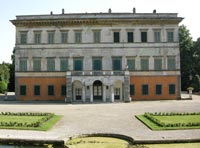 |
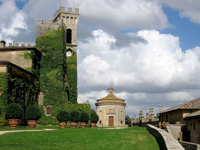 |
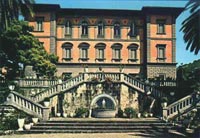 |
||
Villa Reale di Marlia |
Villa Celsa
|
Villa Borbone |
||
| The Powerful Families of Renaissance Italy Two of the most famous, or infamous, Renaissance ruling families were the Medici family of Florence and the Borgia family of Rome. Perhaps less well-known and less powerful than the Medici, the Borgia family has an even more sinister reputation. They are remembered as much for their treachery as for their political accomplishments. The head of the family, Rodrigo Borgia (1431-1503), became Pope Alexander VI in 1492, an office he held until his death in 1503. Although Alexander supposedly died from malaria in 1503 at the age of seventy-two, rumors circulate even now that he met his end after mistakenly eating a piece of poisoned fruit intended for one of his guests. By the end of the fifteenth and the beginning of the sixteenth century, both the Medici and the Borgia families were in trouble. When Lorenzo the Magnificent died in 1492, the Medici were toppled from power in Florence. Two years later, in 1494, the family was exiled and their property taken over by the city of Venice. Cesare Borgia outlived his father by four years, but steadily lost influence. Beset on all sides by his enemies, foremost among them the new pope Julius II, Cesare fled Rome only to be captured in Naples and imprisoned in Spain. He escaped but was killed in battle in 1507, ending the Borgia's dream of establishing a family dynasty on Italian soil. The Renaissance world of Lorenzo de' Medici and Cesare Borgia may have been beautiful and elegant but it proved also to be dangerous and impossible for any one man or family to master. The Albizzi family The Albizzi were one of the oldest families in Florence and led the republican government for two generations. By 1427, they were the most powerful family in the city, and far richer than the Medici. They had been the patrons of genius and cultural icons, but the family was more interested in waging war than sustaining commercial viability. By 1430, their military policy had cost the Florentine taxpayer a fortune and much of their support. Pragmatic pacifists marshaled around Cosimo de'Medici. Maso degli Albizzi, patriach of his family, had two sons, Luca and Rinaldo. From a young age, Luca was friends with Cosimo de'Medici. They shared a passion for classical learning and good conversation. During the 1420s, Luca declared his public allegiance to the Medici family, even marrying Cosimo's cousin. For his hot-headed brother Rinaldo, this was a humiliation too far. The bitter family rivalry had just got personal. Rinaldo's impatience got the better of him. Eager to flush Cosimo out of Florence, he allowed the head of the Medici family to stay alive, gathering support whilst in exile. And Rinaldo's rash decision to besiege the Palazzo Vecchio when he didn't get his way allowed Cosimo to return triumphant. The Albizzi were banished, never to return to power in Florence. The Strozzi family The Strozzi family was an ancient and noble Florentine family. Palla Strozzi (1372-1462) played an important part in the public life of Florence, and founded the first public library in Florence in the monastery of Santa Trinita. Filippo Strozzi il Vecchio (1428-1491), son of Matteo Strozzi and of Alessandra Macinghi is credited with initiating construction of the Strozzi palace in Florence. Filippo II (1488-1538) is probably the most well known member of the family. Although married to Clarice de' Medici, a daughter of Piero di Lorenzo de' Medici and member herself of the Medici family, he was vehemently opposed to the hegemony the Medicis had acquired as the unofficial rulers of the Florentine republic and was among the leaders of the uprising of 1527. After the republic was overthrown in 1530 Alessandro de' Medici attempted to win Filippo Strozzi's support, but Strozzi declined and instead retired to Venice. After the murder of Alessandro in 1537 he assumed leadership of a group of republican exiles with the object of re-entering the city but having been captured and subsequently tortured he committed suicide. Filippo II (1488-1538) is probably the most well known member of the family. Although married to Clarice de' Medici, a daughter of Piero di Lorenzo de' Medici and member herself of the Medici family, he was vehemently opposed to the hegemony the Medicis had acquired as the unofficial rulers of the Florentine republic and was among the leaders of the uprising of 1527. Filippo Strozzi's older son Piero (1500 - 1558), fought in France against Italy and Spain, and was made a Marshal of France in 1554. He took part in the French siege of Calais (1557), and died of wounds incurred in battle at Thionville, in Lorraine, in 1558. The younger son Leone (1515-1554) was a distinguished admiral in the service of France and fought against the Medici. He died of a wound received while attacking Sarlino in 1554. Filippo di Piero Strozzi (1541-1582) served in the French army, and was captured and killed by the Spaniards at the Battle of Terceira. Until its exile from Florence in 1434, the Strozzi family was by far the richest in the city, and was rivaled only by the Medici family, who ultimately took control of the government and ruined the Strozzi both financially and politically. This political and financial competition was the origin of the Strozzi-Medici rivalry. Later, while the Medici ruled Florence, the Strozzi family was ruling Siena. Florence attacked Siena at that time, which caused great animosity between the two families. Soon afterwards, the Strozzi married into the Medici family, essentially giving the Medici superiority. The Strozzi acquired by marriage the titles of Princes of Forano and Dukes of Bagnolo. The Strozzi palace belonged to the family until 1937 when it was sold to the National Insurance Institution 'Istituto Nazionale delle Assicurazioni (INA).From 1999 it became Italian State's property. Today, the Strozzi descendents are still living in Florence. The Rucellai family Giovanni Rucellai is the name of a father (1403–1481) and grandson (1475–1525) of the Rucellai family wool-dyers turned bankers. The former, Giovanni di Paolo, or Giovanni I, as the effective head of the Rucellai family commissioned the building of the Palazzo Rucellai, designed by Leon Battista Alberti and the father of Bernardo Rucellai, the oligarch and humanist. The son-in-law of Palla Strozzi, Giovanni di Paolo was close friends with Piero di Cosimo de' Medici and his wife, Lucrezia Tornabuoni. He served as Prior in 1463 and as Gonfaloniere di Giustizia in 1475. His eldest son, Bernardo, married Nannina de' Medici. Giovanni the Elder was well-acquainted with the classics - he kept a Zibaldone in which his own translations of passages from Greek and Latin authors, like Aristotle and Boethius as well as the letters of Seneca the Younger were copied out. Giovanni di Paolo was an outstanding patron of the arts, matched only by Cosimo de' Medici in fifteenth-century Florence. He commissioned works for the Palazzo Rucellai from such renowned artists as Andrea di Castagno, Desiderio da Settignano, Filippo Lippi, Piero Pollaiuolo, Uccello, Verrocchio, Domenico Veneziano, Vittorio Ghiberti and Giovanni Bertini. The marble Alberti facade of Santa Maria Novella was but one of the family's donations of public art. The latter, Giovanni di Bernardo, or Giovanni II, was an Italian humanist, poet, dramatist and man of letters, and a cousin of Pope Leo X. He was also an important figure in the fields of commerce and politics, being in his lifetime the third richest man in Florence, a situation that was added to by his marrying into the powerful Strozzi and Medici families. The Pazzi family Like the Albizzi, the Pazzi were an older, nobler lineage than the Medici. They could trace their ancestry back to Pazzino de'Pazzi, the first knight to scale the wall of Jerusalem during the First Crusade. The Pazzi were also wealthy bankers, and enjoyed good commercial terms with their Medici rivals. They even sealed these friendly relations through inter-marriage. But Lorenzo de'Medici, wary of Pazzi ambition, kept his rivals out of government office during the 1470s. When a greedy nephew of Pope Sixtus IV approached the younger Pazzi with a plan to seize Medici land, they found the chance for power in Florence irresistible. The ambitious sons of Jacopo de'Pazzi led an audacious plot against the Medici. The plot failed. Executed at the hands of furious Florentines, the name of Pazzi was erased from the city, their homes looted and destroyed. One conspirator was hunted down in the streets of Constantinople, and handed over by the Ottoman Emperor. Even he knew that Lorenzo de'Medici was not to be messed with. Perhaps by coincidence, the Italian noun for a hot-headed fool is pazzo - and some have suggested that the Italian-American slang, patsy, meaning a scapegoat or stooge, is derived from the unfortunate Pazzi assassins. The Brancacci family Felice di Michele Brancacci (born 1382 - fl. 15th century) was a Florentine silk merchant, best known for commissioning the decoration of the Brancacci Chapel. The nephew and heir of Piero di Piuvichese Brancacci, he was involved in Mediterranean silk trade, and also acted as a diplomat. Felice is known to have won a joust held to celebrate Florence's submission of Pisa in 1406. He acted as a diplomat for the Florentine Republic, and visited the court of the Sultan of Egypt in 1422. He was also a member of the city's Board of Maritime Consuls. As a result of the decline in the wool trade, Brancacci's wealth as a silk merchant increased rapidly. In May 1431 he married Lena, daughter of Palla Strozzi, a union that put him at the centre of Florentine politics. In 1433, a number of the most powerful families of the city – including the Strozzis – had driven the family of Cosimo de Medici into exile. When the Medicis returned in triumph the next year, Brancacci was among those expelled as an enemy of the Republic, in spite of his attempts to stay out of active political ploys. Sometime after 1423 and before 1425 Brancacci supposedly commissioned the painter Masaccio to decorate the walls of the Brancacci chapel left by his uncle. The subject was the life of Saint Peter, the name-saint of the founder, and the patron saint of the Brancacci family. The choice also reflected support for the Roman papacy during the Great Schism. Masolino was later joined by the younger artist Tommaso Cassai, or Masaccio. Masaccio's contributions to the frescoes – including The Tribute Money – are considered the most important, and central to the development of renaissance art. Both artists left before the work was completed, however, in 1427 or 28. It was not until the 1480s, when the Brancaccis were allowed to return from exile, that the work was finished, by Filippino Lippi. The Borgia family Their name has become a byword for murder and incest, making the Borgia the most notorious family in Renaissance Italy. They were not friends of the Medici. Rodrigo Borgia, the corrupt Pope Alexander VI, had at least two illegitimate children. His sociopath son, Cesare, was born just a year after Giovanni de'Medici, in 1476. Cesare was made a cardinal in 1493 and his presence in Rome under the rule of his father made the city off-limits to the Medici cousins. Cesare marched through Rome with weapons barely hidden under his silk robes, taking pot-shots at prisoners and murdering close relations. Rumored to have committed incest with his beautiful sister, Lucrezia, he stabbed her lover to death at the feet of the Pope, and strangled her second husband, who was only 18-years-old. After his father's death, Cesare was exiled to Spain, where he died in 1507. Lucrezia went on to patronize some of the greatest talents of the High Renaissance, including the poet Ariosto, and the artist Titian. |
||||
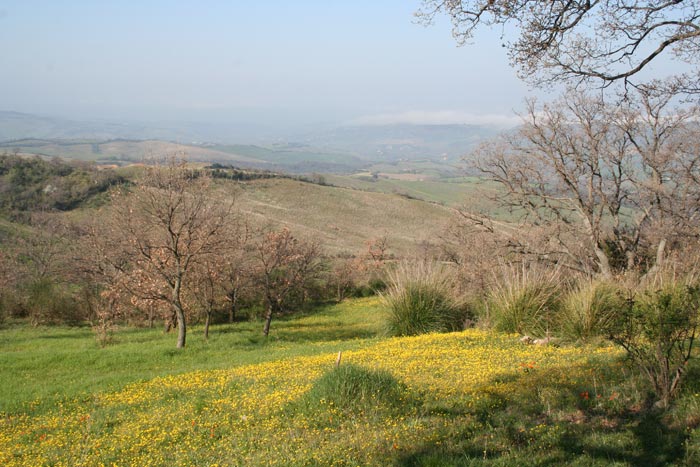 |
||||
The hidden secrets of southern Tuscany | Podere Santa Pia
|
||||
| Wikimedia Commons has media related to Palazzo Medici-Riccardi and to the Garden of Palazzo Medici-Riccardi | ||||


